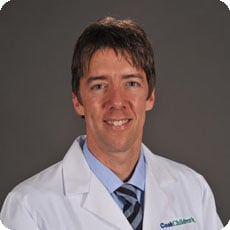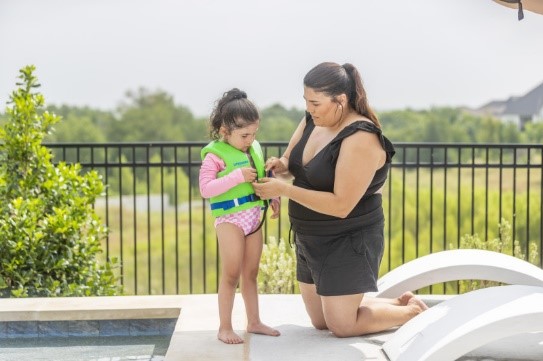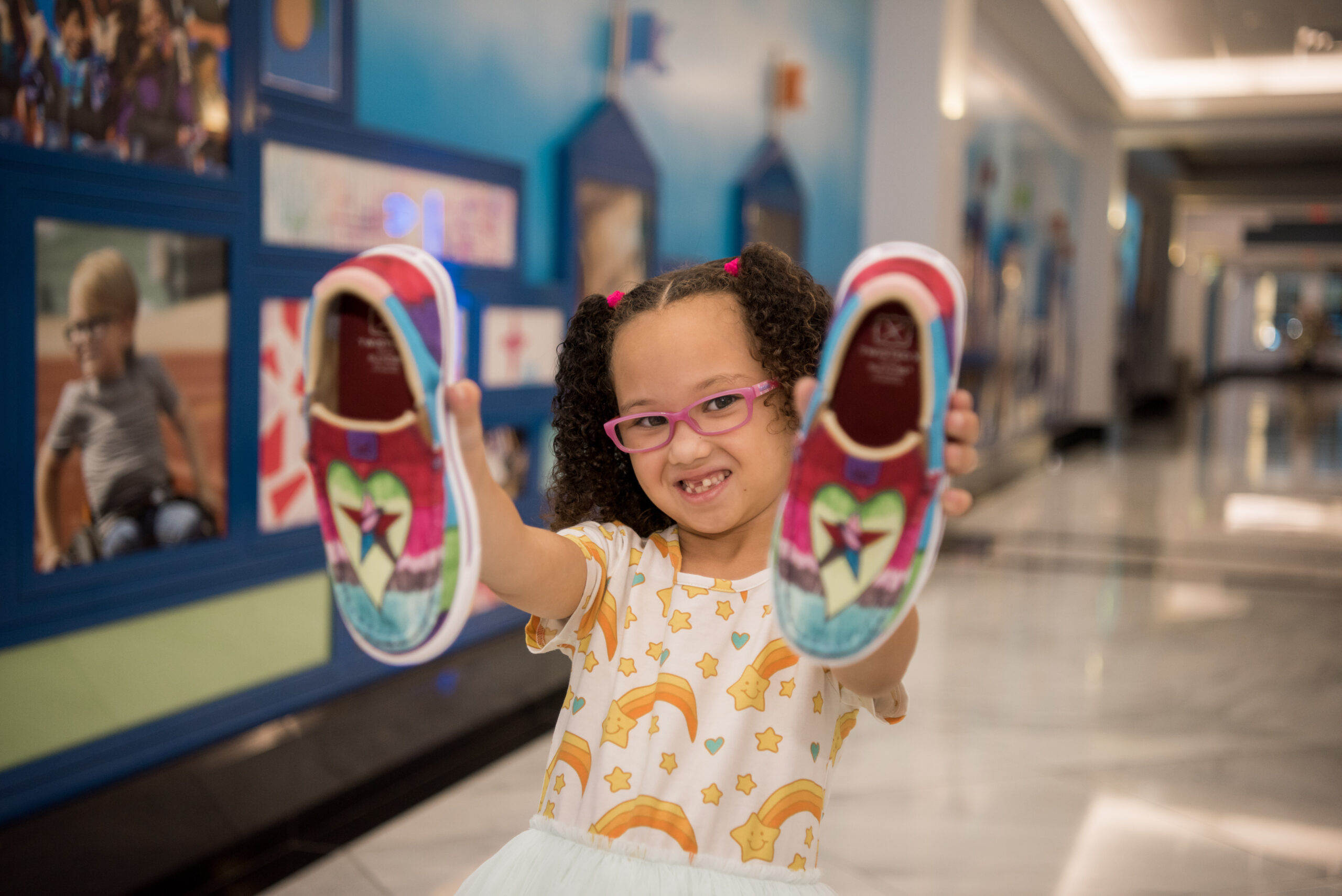A Look Behind One of the Most Difficult Jobs in Medicine
How a pediatric neuro-oncologist deals with rare diseases, death and leading a top-level team

The last thing Jeff Murray, M.D., wants to do is be interviewed for this story.
It’s not about being rude or even shy, it’s just he wants to make darn sure the love is spread around for the people that make up the Neuro-Oncology Program at Cook Children’s.
“That’s probably the reason why I don’t like to do these interviews! I don’t want the attention on me,” Dr. Murray said. “The bottom line is the kids and the team that takes care of them. It’s not me. There has to be a leader. I understand the hierarchy that has to be there. I accept that, but begrudgingly. I am proud of our Neuro-Oncology team. We are truly interchangeable in so many ways.”
This is not just humble speak on Dr. Murray’s part. A large part of the reason he became Medical Director of Neuro-Oncology is because one of his gifts is to build a solid, capable team that he empowers to do their work to the best of their ability.
When asked to talk about Dr. Murray, Mandy Mansell, the nurse practitioner for the Neuro-Oncology Program, says she’s “surprised he is letting you do a story on him.” Mansell praises Dr. Murray as a teacher and says he’s “constantly looking to work his way out of a job by training his staff to function so well.”
Dr. Murray is fond of saying if he gets hit by a bus, his team of Mansell, Neuro-Oncology Nurse Ashleigh Hines and Kelly Rand, the team’s social worker, could step right in and do his job.
“No other team of medical providers can say that they have educational support like we do,” Mansell said. “He does trust us implicitly and values our gut instinct/experiences, because he has taught us those things. He doesn’t view himself as the leader, but more as just another member of the team. Our structure flows naturally out of this. Communication is fluid and immediate because we all contribute to the turning of the wheel in Neuro-Onc. He is constantly telling us that we don’t need him or that we ‘run the program.’ This is validating and continues to make us want to work hard.”

Communication is key for Dr. Murray. Watch him throughout the day and you’ll find him on his phone or on his computer. He’s either e-mailing his co-workers on patient care or checking with colleagues across the nation on the best way to handle a case. He’s also there for those same colleagues when they need help from him.
Dr. Murray jokes that he texts with the neurosurgeons throughout the day like they are teenagers, but adds they are in constant contact for the very serious reasons of making sure they are providing the best care possible for their patients.
“Dr. Murray has been an invaluable addition to our Neurosciences team,” said John Honeycutt, M.D., medical director of Neurosurgery at Cook Children’s. “He has spearheaded our Neuro-Oncology program. Jeff works very closely with us about each individual patient. We have continuous back-and-forth conversations, with emails and texts at the time of diagnosis and initial treatments (surgery) and after care. He readily assumes responsibility for each patient and immediately has his Neuro-Onc team start working on appointments, follow-up, treatment plans, etc. This easy communication with his colleagues allows seamless transition of care and provides personalized care for each patient and their family. Families love the thoroughness and honesty that Jeff brings.”
Linda Margraf, M.D., a pathologist at Cook Children’s, says no one goes as far as Dr. Murray to make sure everyone is kept in the loop of patient care. He doesn’t just send a piece of tissue or wait for the scan to come back. He sends as much background as possible to the pathologists to help them before they even look at the microscope.
He sends emails to Pathology to inform staff of details about an upcoming tumor surgery including the radiology findings and any significant clinical concerns. He visits the team with any special issues and when time allows, he will present patient cases at the Neuro-Oncology tumor board prior to tumor surgery so the pathologists can review the images and hear about plans and concerns of the neurosurgeons regarding the case.
“For some types of tumors (and many other conditions), knowing what the imaging studies show is quite important in rendering an accurate pathology diagnosis,” Dr. Margraf said. “His approach also improves communication between the various specialties, both during the tumor board conference and after. He always emphasizes how much Neuro-Oncology is a team effort and all caregivers, not just the pathologist, benefit from this approach. I think this truly optimizes care for the patient and family.”
Dr. Murray’s team approach and emphasis on communication includes more than physicians. On every email, he copies Rand, the social worker, and Peggy Johnson in Pastoral Care. He consistently invites team members (nurse practitioners, nurses, social workers and chaplain) to attend every formal diagnosis conference and every progression on treatment or relapse conference, as well as every end-of therapy conference.
“He trusts that everyone will bring their professional best to the table for our patients and their families,” Rand said. “He values every team member and their professional expertise, and he actively seeks out the knowledge and thoughts we each have to offer. Dr. Murray is as brilliant as he is humble. He’ll often say that our RN, Ashleigh, and nurse practitioner, Mandy, are the brains behind the whole operation. I think that shows how highly he values his team members and their hard work and commitment to our patients.”
The Neuro-Oncology team faces tough challenges every day. They treat patients for tumors in the brain, brainstem, optic tract and spine, as well as neurofibromatosis and more.
Dr. Murray admits that these day-to-day battles of life and death wear on him. He places the heartache after the death of a patient away somewhere and says he may walk around with a permanent case of post-traumatic stress disorder.
But Dr. Murray moves on and says he tries his best to put his job behind him while he’s at home with his wife and son.
“Obviously you feel for these families and certainly after I had my own child it’s become more difficult as it would for anybody because you start feeling … putting yourself in the shoes of those parents,” Dr. Murray said. “Of course it’s most difficult when I’m dealing with a child who is exactly the age of my child and happens to be boy like my own son. It’s very difficult. I have to catch my emotions and be relatively emotion free when I’m talking to families like that. So it’s gotten more difficult since I’ve had a child, but not impossible.
“And also except for a couple of exceptions most of these kids will be cured. They will be fixed. They may have some damage and some side effects that last a long time but most of these kids are going to be OK. I’ve learned a lot about the human spirit from a parent’s point of view. It is stronger than you can imagine. It’s just witnessing it over and over again. Parents and families in spite of hearing horrible news are almost always able to rally and create something special for their child. Whether it’s a child who is going to live or a child who is going to die, it’s remarkable how families can create an environment around them to create something really good.”
Just like the Neuro-Oncology family he’s created at Cook Children’s … something really good.
If we had one wish it would be that no child would ever experience cancer. That’s why we’re asking you to join forces with Cook Children’s oncologists, researchers, patients and families to help make that wish come true. Click here to help.
Neuro-Oncology at Cook Children’s
Our distinguished neuro-oncology team is highly regarded for their active role in national and international clinical research trials and relentless pursuit of seeking cures. When you place your child in our care, you know that he or she is in the capable hands of some of the finest neuro-oncology specialists in the country, if not the world. These men and women are dedicated experts in the care and treatment of tumors in the brain, brainstem, optic tract and spine, as well as neurofibromatosis, vascular malformations, dermoid lesions andmore.
You can learn more about the accomplishments, advancements and successes that the Cook Children’s Neuro-Oncology team has achieved, and how they are helping children now by clicking here.


